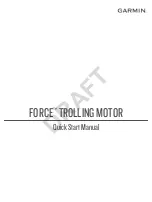
E
1-7
EMB40010
BASIC BOATING RULES
(Rules of the road)
Just as there are rules which apply when
you are driving on streets and high ways,
there are waterway rules which apply
when you are driving your boat. These
rules are used internationally, and are
also enforced by the United States Coast
Guard and local agencies. You should be
aware of these rules, and follow them
whenever you encounter another vessel
on the water.
Several sets of rules prevail according to
geographic location, but are all basically
the same as the International Rules of the
Road. The rules presented here in your
Owner’s Manual are condensed, and have
been provided for your convenience only.
Consult your local U.S. Coast Guard
Auxiliary or Department of Motor
Vehicles for a complete set of rules gov-
erning the waters in which you will be
using your boat.
STEERING AND SAILING RULES AND
SOUND SIGNALS
Whenever two vessels on the water meet
one another, one vessel has the right-of-
way; it is called the “stand-on” vessel.
The vessel which does not have the right-
of-way is called the “give-way” or “bur-
dened” vessel. These rules determine
which vessel has the right-of-way, and
what each vessel should do.
Stand-on vessel
The vessel with the right-of-way has the
duty to continue its course and speed,
except to avoid an immediate collision.
When you maintain your direction and
speed, the other vessel will be able to
determine how best to avoid you.
Give-way vessel
The vessel which does not have the right-
of-way has the duty to take positive and
timely action to stay out of the way of the
Stand-On vessel. Normally, you should
not cross in front of the vessel with the
right-of-way. You should slow down or
change directions briefly and pass behind
the other vessel. You should always move
in such a way that the operator of the
other vessel can see what you are doing.
“The general prudential rule”
This rule is called Rule 2 in the
International Rules and says,
‘In obeying and construing these rules
due regard shall be had to all dangers of
navigation and collision, and to any spe-
cial circumstances, which may render a
departure from the above rules necessary
in order to avoid immediate danger.’
In other words, follow the standard rules
except when a collision will occur unless
both vessels try to avoid each other. If
that is the case, both vessels become
“Give-Way” vessels.
66M-9-17-1 2/27/03 9:53 AM Page 12
Summary of Contents for F15C
Page 1: ...F15C OWNER S MANUAL U S A Edition LIT 18626 05 47 ...
Page 2: ......
Page 22: ...E MEMO ...
Page 82: ...4 11 E 500 hours 1000 hours 2 5 years 5 years Timing belt Replacement 1 Item Actions Every ...
Page 83: ...4 12 E 103192 EML00011 GREASING Yamaha marine grease Water resistant grease ...
Page 104: ...E MEMO ...
Page 115: ...EMP00010 Chapter 6 INDEX INDEX 6 1 1 2 3 4 5 6 E ...
Page 126: ...PLACE POSTAGE HERE ATTN WARRANTY DEPARTMENT Warranty card 2 27 02 11 47 AM Page 2 ...











































